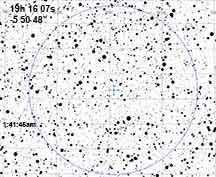




This is a decent rank event that passes through downtown Santa Cruz and Live Oak. Karl's only barely inside the northern 1-sigma uncertainty limit. But the star is decently bright, the altitude is good, fog may stay away, and the duration is up to 0.9s and should be quite do-able.
Nominal odds of a 'hit' from home: me 82%, Kirk 56%, Karl 15%
Alt=47, Az=171 in Aquila, just a couple degrees below and left of the tail feathers
 |
 |
 |
 |
 |
I observed from my driveway, at 8x setting, and got a 0.66s event passing the FP test well. I used the same-brightness very close neighbor to hopefully capture correlated seeing variance. The best solution was 32 smoothing. At 8x that's about 2s smoothing, length. Skies were clear, dry, no problems. Seeing was OK, not great, not horrible. The altitude was high enough to not cause undue seeing trouble.
First try. smoothing = 32, no time offset. Used all of light curve including the segment with the "glitch".
magDrop report: percentDrop: 82.4 magDrop: 1.886 +/- 0.456 (0.95 ci)
DNR: 3.66
D time: [08:41:44.6719]
D: 0.6800 containment intervals: {+/- 0.0299} seconds
D: 0.9500 containment intervals: {+/- 0.0744} seconds
D: 0.9973 containment intervals: {+/- 0.1498} seconds
R time: [08:41:45.2922]
R: 0.6800 containment intervals: {+/- 0.0299} seconds
R: 0.9500 containment intervals: {+/- 0.0744} seconds
R: 0.9973 containment intervals: {+/- 0.1498} seconds
Duration (R - D): 0.6203 seconds
Duration: 0.6800 containment intervals: {+/- 0.0431} seconds
Duration: 0.9500 containment intervals: {+/- 0.0975} seconds
Duration: 0.9973 containment intervals: {+/- 0.1828} seconds
====================================================================
2nd Try. Trimmed beyond 1 min after the event, when a bump or contrail perhaps? caused a glitch on all stars, and a 2-integration 'event' with some low-ish valued on either side. Did not have the profile of an occultation, and the 3 ref stars also showed similar behavior. Judgement: not a real event, but likely to worsen the FP test results. So I trimmed it and ran again, and also increased the smoothing length on the ref1 star. Improved FP test a bit, but only a bit. Now it's bang-on 4-sigma
magDrop report: percentDrop: 82.2 magDrop: 1.874 +/- 0.446 (0.95 ci)
DNR: 3.58
D time: [08:41:44.6523]
D: 0.6800 containment intervals: {+/- 0.0296} seconds
D: 0.9500 containment intervals: {+/- 0.0800} seconds
D: 0.9973 containment intervals: {+/- 0.1557} seconds
R time: [08:41:45.2922]
R: 0.6800 containment intervals: {+/- 0.0296} seconds
R: 0.9500 containment intervals: {+/- 0.0800} seconds
R: 0.9973 containment intervals: {+/- 0.1557} seconds
Duration (R - D): 0.6399 seconds
Duration: 0.6800 containment intervals: {+/- 0.0439} seconds
Duration: 0.9500 containment intervals: {+/- 0.0992} seconds
Duration: 0.9973 containment intervals: {+/- 0.1774} seconds
 |
 |
 |
 |
 |
I used a very tight 11 px search box, to make sure that when the target disappeared, the neighboring ref1 star did not get jumped to. Still used 4px sized aperture for all stars. I think the scatter in the light curves and the fact there were only 5 points inside the occultation were what made the FP test not get better than 4-sigma. It's bang-on the predicted time, as is Kirk Bender's occultation time, so I think both our data sets will be accepted
3rd Try - this time I took the same PyMovie photometry and search for events of duration 4-5 integrations. This finally gave a FP test better than 5-sigma, better S/N and slightly deeper event, and will be the one reported to IOTA. The PyOTE log will be long. The final set of numbers was the best solution, in good agreement with Kirk Bener's also 5+ sigma FP test results 2 - 3 miles away.
magDrop report: percentDrop: 85.7 magDrop: 2.115 +/- 0.232 (0.95 ci)
DNR: 3.80
D time: [08:41:44.6772]
D: 0.6800 containment intervals: {+/- 0.0230} seconds
D: 0.9500 containment intervals: {+/- 0.0597} seconds
D: 0.9973 containment intervals: {+/- 0.1233} seconds
R time: [08:41:45.3423]
R: 0.6800 containment intervals: {+/- 0.0230} seconds
R: 0.9500 containment intervals: {+/- 0.0597} seconds
R: 0.9973 containment intervals: {+/- 0.1233} seconds
Duration (R - D): 0.6651 seconds
Duration: 0.6800 containment intervals: {+/- 0.0338} seconds
Duration: 0.9500 containment intervals: {+/- 0.0762} seconds
Duration: 0.9973 containment intervals: {+/- 0.1378} seconds
 |
 |
 |
I got a .5697 event at the predicted time for 2000 WN152, 4x from home.
I used a TME aperture, and the result was noisy and I thought it wouldn't pass FP, but it did pass 5 sigma (6.9 according to the log).
For the smoothing reference star, I used the one close to the target, but it was too dim for a tracking star, so I used others for tracking. I tried a 12 stack of static apertures and the best was not quite as good as the TME results.
My DNR is not as high as yours at 8x, but the containment intervals are close. Maybe I should have done it at 8x, but at the time it looked do-able at 4x.
magDrop report: percentDrop: 91.1 magDrop: 2.623 +/- 1.728 (0.95 ci)
DNR: 2.60
D time: [08:41:44.7277]
D: 0.6800 containment intervals: {+/- 0.0232} seconds
D: 0.9500 containment intervals: {+/- 0.0696} seconds
D: 0.9973 containment intervals: {+/- 0.1670} seconds
R time: [08:41:45.2974]
R: 0.6800 containment intervals: {+/- 0.0232} seconds
R: 0.9500 containment intervals: {+/- 0.0696} seconds
R: 0.9973 containment intervals: {+/- 0.1670} seconds
Duration (R - D): 0.5697 seconds
Duration: 0.6800 containment intervals: {+/- 0.0358} seconds
Duration: 0.9500 containment intervals: {+/- 0.0882} seconds
Duration: 0.9973 containment intervals: {+/- 0.1977} seconds
 |
 |
 |
 |